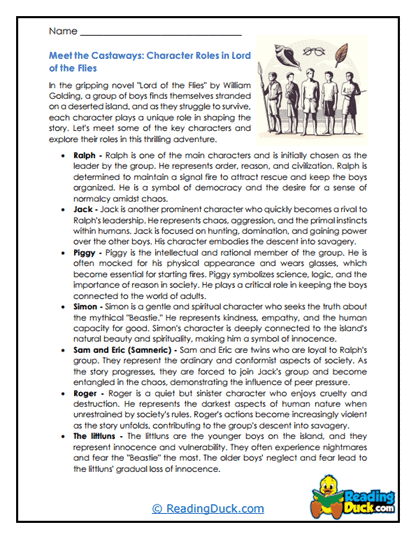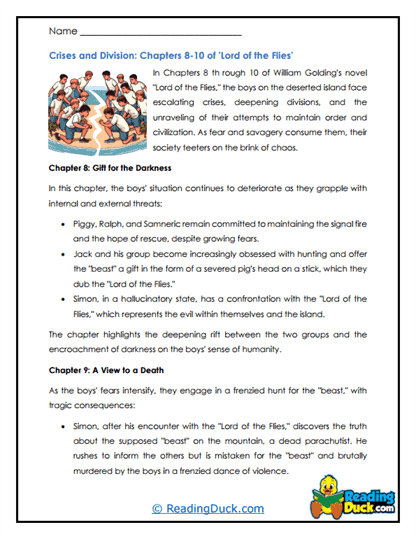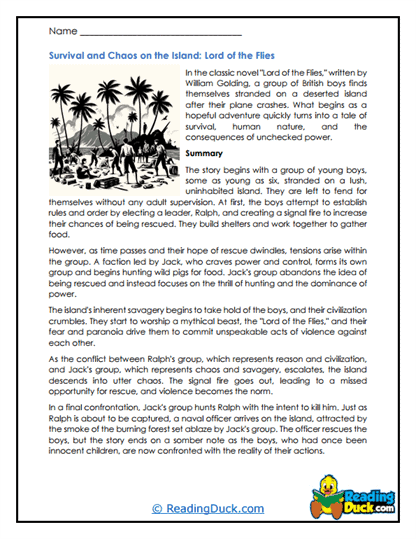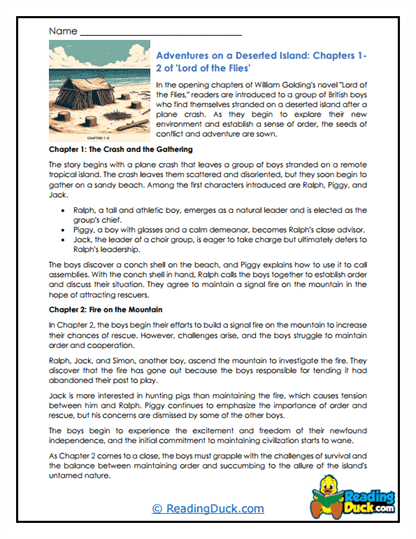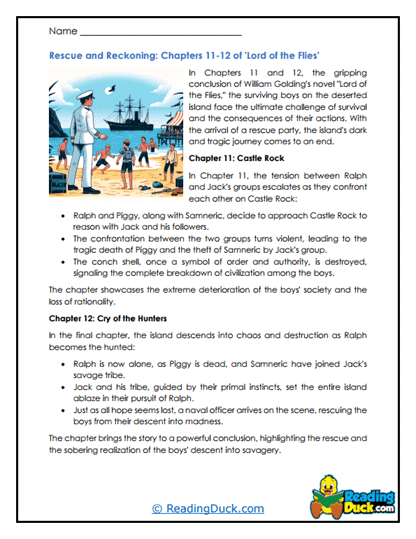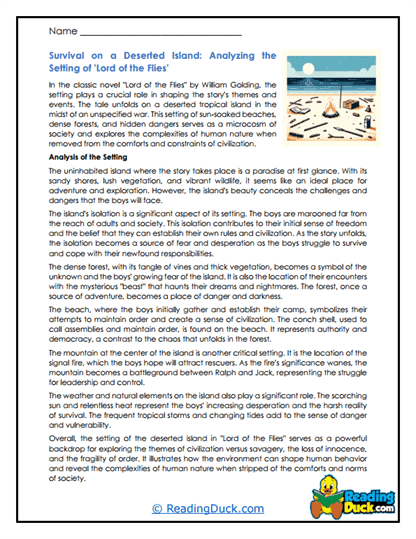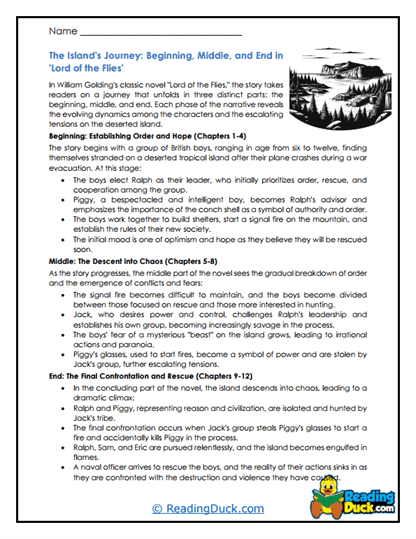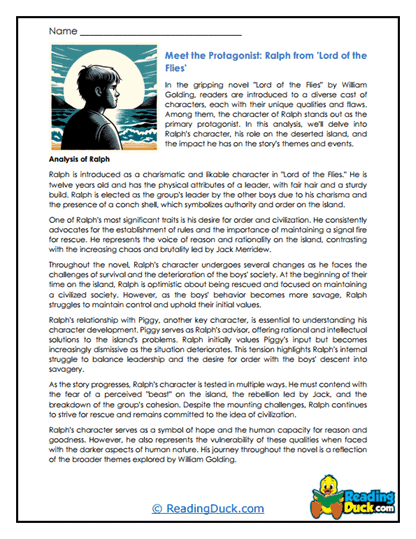Lord of the Flies Worksheets
About Our Lord of the Flies Worksheets
Our Lord of the Flies worksheets offer an immersive and insightful journey into William Golding’s classic novel, helping students explore its complex themes and characters. These worksheets are designed to engage students in critical thinking and foster a deeper understanding of the text, making them a valuable resource in any literature curriculum.
The Literature category includes a wide array of notable and classical works, such as 1984, Fahrenheit 451, Of Mice and Men, Pride and Prejudice, Romeo and Juliet, The Diary of Anne Frank, The Great Gatsby, The Scarlet Letter, and To Kill a Mockingbird. Each collection is carefully organized to provide a thorough examination of one literary work at a time, focusing on key themes, character analysis, and the societal impact of these works.
Within each category, you will find several worksheet sets, each designed to focus on different aspects of the literary work. For Lord of the Flies, these worksheet sets include:
- Multiple Choice Questions: These questions help students grasp the basic plot, characters, and themes of the novel. By answering these questions, students can demonstrate their comprehension of the text and identify key elements that are critical to understanding the story.
- Short Answer Questions: This format encourages students to delve deeper into the text, allowing them to analyze characters, themes, and significant events in their own words. These questions are designed to challenge students to think critically and express their interpretations clearly.
- Open-Ended Questions: These questions invite students to reflect on their personal thoughts, opinions, and feelings about the novel. By engaging with the material on a personal level, students can develop a stronger connection to the text and enhance their ability to articulate their ideas.
Each worksheet set is designed to assess students’ understanding of the material while encouraging them to engage deeply with the text. An answer key is provided for every question sheet, ensuring that educators can easily assess student progress. All worksheets are available as PDF files, which can be easily viewed electronically, downloaded, and printed.
Exploring the Themes and Characters of Lord of the Flies
When introducing William Golding’s Lord of the Flies to students, it’s important to highlight that this novel is much more than just a story about boys stranded on an island; it’s a powerful exploration of human nature, society, and the thin veneer of civilization that can easily be stripped away.
Key Aspects of Lord of the Flies to Understand:
- The Struggle Between Civilization and Savagery: One of the central themes of Lord of the Flies is the conflict between the impulse to maintain order and the instinct to descend into chaos. The novel illustrates this struggle through the boys’ attempts to establish rules and create a society on the island, only to see their efforts unravel as they give in to their more primal instincts.
- The Nature of Leadership: The novel presents different models of leadership through characters like Ralph, who represents order and democracy, and Jack, who embodies an authoritarian rule based on fear and power. The tension between these two approaches to leadership offers students a way to explore the dynamics of power and the consequences of different leadership styles.
- Loss of Innocence: Lord of the Flies is also a story about the loss of innocence. The boys begin their time on the island with a sense of adventure, but as the story progresses, they are forced to confront the darker aspects of their nature. The novel challenges students to consider how the environment and circumstances can change people, particularly in extreme situations.
- The Symbolism of the “Beast”: The “beast” in Lord of the Flies symbolizes the fear and savagery that lurks within all humans. The boys’ growing fear of the beast reflects their descent into barbarism, as they project their inner turmoil onto an imagined external threat. This aspect of the novel allows students to explore how fear can be used as a tool for control and how it can lead to irrational behavior.
- The Role of Symbols: Golding uses several powerful symbols throughout the novel, such as the conch shell, which represents order and authority, and the “Lord of the Flies” itself, which symbolizes the inherent evil within humanity. Understanding these symbols helps students appreciate the deeper layers of meaning in the novel and encourages them to think critically about how symbols can convey complex ideas.
By exploring these themes and characters, students can gain a deeper understanding of Lord of the Flies and its exploration of human nature and society. The novel challenges readers to consider the darkness that lies within us all and the importance of maintaining the structures of civilization to keep that darkness at bay.
Impact and Legacy of Lord of the Flies
William Golding’s Lord of the Flies has had a significant impact on literature and culture since its publication in 1954. The novel’s exploration of human nature, the breakdown of society, and the loss of innocence has resonated with readers for decades, making it one of the most influential works of the 20th century.
Socio-Cultural History:
- Post-War Context: Lord of the Flies was written in the aftermath of World War II, a time when the world was grappling with the horrors of war and the capacity for human cruelty. Golding, who served in the Royal Navy during the war, drew on his experiences to create a novel that examines the darker side of human nature. The book reflects the disillusionment of the post-war generation and the fear that civilization could easily collapse into barbarism.
- Cold War Influence: The novel also gained significance during the Cold War, as it echoed the global tensions between democracy and totalitarianism. The conflict between Ralph and Jack can be seen as a microcosm of the broader ideological battles of the time, making Lord of the Flies a relevant commentary on the potential for societal breakdown.
Cultural Impact:
- Literary Influence: Lord of the Flies has influenced countless works of literature, particularly in the dystopian genre. Its exploration of the breakdown of society and the inherent darkness within humanity has inspired other authors to examine similar themes in their own work. The novel continues to be studied in classrooms around the world, serving as a powerful tool for discussions on human nature, morality, and the fragility of civilization.
- Adaptations and Interpretations: The novel has been adapted into several films, stage productions, and even parodied in popular culture. Each adaptation brings a new perspective to Golding’s story, helping to keep the novel relevant for new generations of readers. These adaptations have also sparked discussions about the different ways in which the novel’s themes can be interpreted and understood.
- Relevance Today: In a world where issues of power, leadership, and the potential for societal breakdown are still highly relevant, Lord of the Flies remains a crucial text for understanding the human condition. The novel continues to resonate with readers today, as it challenges them to confront the darker aspects of human nature and the importance of maintaining the structures that hold society together.
Enduring Legacy:
Lord of the Flies is more than just a novel; it is a profound exploration of the human psyche and the thin line between civilization and savagery. Its themes continue to resonate today, making it a powerful tool for understanding the complexities of human nature and society. The novel’s legacy is evident in its continued popularity and its influence on discussions about morality, leadership, and the potential for darkness within us all.
Encouraging Students to Appreciate Literature
As educators, one of our most important tasks is to help students develop an appreciation for literature. Literature opens up new worlds, perspectives, and ideas, helping students develop empathy, critical thinking skills, and a deeper understanding of the human experience. Here are some tips on how teachers and parents can use these Lord of the Flies worksheets to encourage students to engage more deeply with literature:
Using Worksheets Effectively:
- Promote Active Discussions: After students complete the worksheets, encourage them to discuss their answers and interpretations of the text. The open-ended questions are particularly effective for sparking thoughtful discussions about the novel’s themes, characters, and symbols. By engaging in these discussions, students can gain new insights and deepen their understanding of the text.
- Draw Connections to Real Life: Help students connect the themes of Lord of the Flies to real-world situations. Discuss how the novel’s exploration of power, leadership, and societal breakdown relates to current events and historical examples. This approach can help students see the relevance of literature in understanding the world around them.
- Encourage Creative Projects: Motivate students to engage with the novel creatively. They might create a storyboard of key scenes, write an alternative ending, or produce a short film that explores the novel’s themes. These creative projects allow students to express their understanding of the text in unique and personal ways, making the literature more tangible and exciting.
- Incorporate Group Work: Use the worksheets as a basis for group activities. Students can work together to answer questions, analyze characters, or role-play scenes from the novel. Group work encourages collaboration and allows students to learn from each other’s perspectives and interpretations.
- Foster Personal Reflections: Encourage students to keep a reading journal where they can reflect on their thoughts and feelings about the novel. The open-ended questions from the worksheets can serve as prompts for these reflections, helping students connect personally with the material and develop a deeper appreciation for the themes explored in Lord of the Flies.
Creating a Literary Environment:
- Build a Classroom Library: Stock your classroom or homeschool environment with a variety of books, including other works by William Golding and related literature that explores similar themes. This encourages students to explore beyond the assigned reading and discover new authors and genres that interest them.
- Author Study: Consider doing an author study on William Golding. Explore his life, other works like The Inheritors or The Spire, and his influence on literature and society. This can provide students with a broader context for understanding Lord of the Flies and appreciating Golding’s contributions to literature.
- Host Literature Circles: Organize literature circles where students can discuss the novel in small groups. Assign each group a specific aspect of the novel to focus on, such as character development, symbolism, or thematic analysis. This allows students to delve deeper into the text and share their insights with their peers.
By using these strategies, teachers and parents can help students develop a deeper appreciation for literature and inspire a lifelong love of reading. The Lord of the Flies worksheets are a valuable tool in this process, providing a structured yet flexible way to explore one of the most important novels of the 20th century. Through these activities, students will not only understand the content of Lord of the Flies but also connect with its themes and messages on a personal level, enriching their educational experience.

